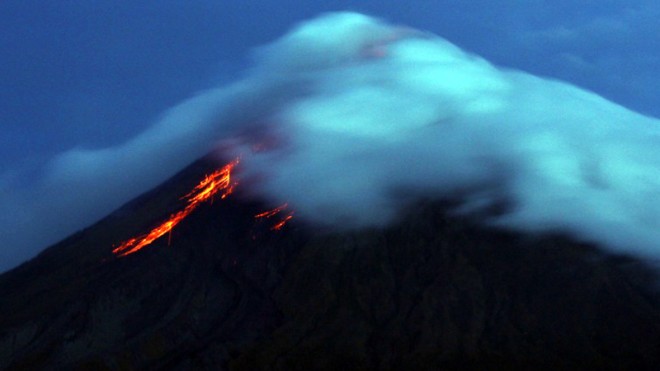Philippines evacuates farm animals as volcano simmers

Lava flows from the crater of Mayon volcano seen from Legazpi City, Albay province, on Sept. 17, 2014. After evacuating about 55,000 people, Philippine authorities said Sunday, Oct. 5, they were laboring to move thousands of farm animals from areas threatened by the country’s most active volcano. AFP PHOTO/CHARISM SAYAT
MANILA, Philippines–After evacuating about 55,000 people, Philippine authorities said Sunday they were laboring to move thousands of farm animals from areas threatened by the country’s most active volcano.
About 3,000 animals, mostly water buffaloes, cows and goats, are still in the six-kilometer (3.8-mile) “danger zone” around Mayon volcano which is showing signs of possibly erupting, said Albay Gov. Joey Salceda.
“We have been doing this for two weeks so there may be about 3,000 animals left that we have to chase after,” he said on radio station DZMM.
He said about 6,000 pet dogs and other “animal companions” and 10,000 farm animals had already been moved to safety.
The pigs owned by people in the danger zone had already been slaughtered or sold, he added.
Article continues after this advertisementRegional civil defense director Bernardo Alejandro said that the animals were being taken to government agricultural centers until the danger had passed.
Article continues after this advertisementHe told AFP that moving the animals was crucial so that farmers in evacuation centers don’t frequently return to the danger zone to take care of them.
The 2,640-meter (8,070-foot) Mayon, located about 330 kilometers (200 miles) southwest of Manila, is a draw for local and foreign tourists but an enduring danger for anyone getting too close.
The volcano has been simmering for months, indicating an eruption could take place, said the resident volcanologist for Mayon, Ed Laguerta.
He told AFP that if rainwater gets trapped in the volcano’s edifice, this could cause a steam explosion which in turn could trigger an outflow of magma.
Residents living in the danger zone have since been moved to makeshift evacuation centers, usually schools and other government buildings.
Four foreign tourists and their local tour guide were killed when Mayon last erupted, in May 2013.
In December 2006, 1,000 people died as a strong typhoon hit near Mayon, unleashing an avalanche of volcanic mud from an eruption four months earlier.
In 1814, more than 1,200 people were killed when lava flows buried the town of Cagsawa.
RELATED STORIES
Expert: Mayon ‘getting fatter’
Magma rising as Mayon lull is over